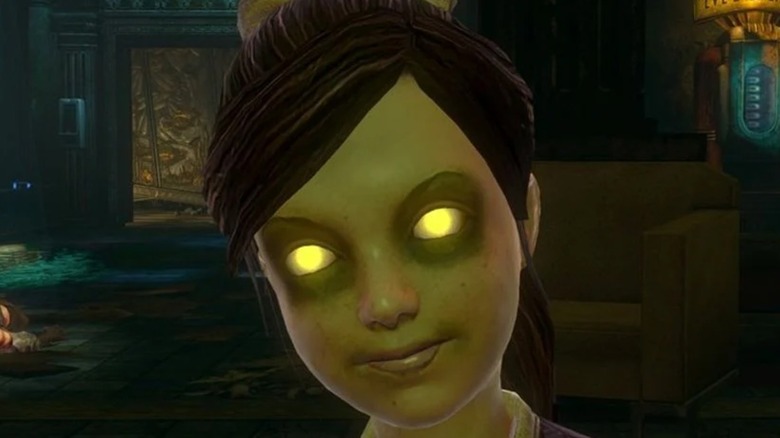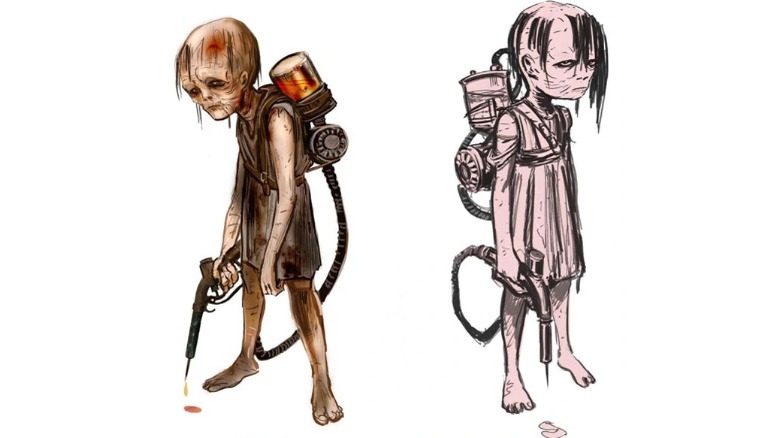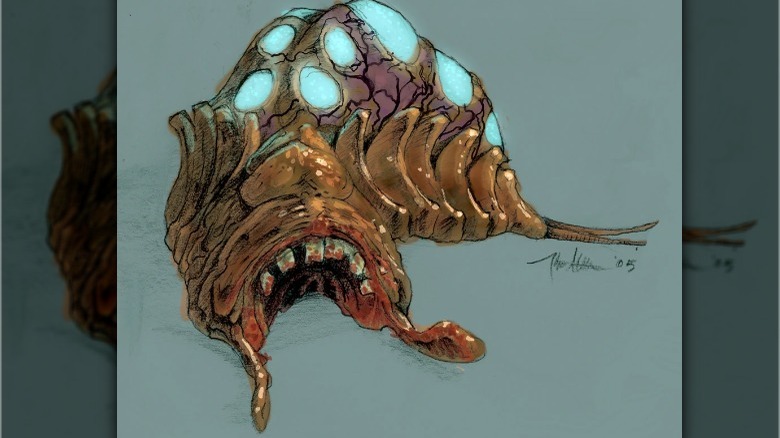BioShock's Original Design For Its Little Sisters Was So Much Scarier
We may receive a commission on purchases made from links.
The original "BioShock" from Irrational and 2K Games had a lot going for it. One of the aspects that helped it stand out from other survival horror games is the setting. The underwater city of Rapture is a dystopian nightmare illustrating the horrors of unbridled capitalism. Venture capitalist Andrew Ryan founded this community on the principles of progress without oversight after feeling burdened by the socialist policies introduced by FDR's New Deal. This led to unethical scientific experimentation and the widespread distribution of ADAM, an addictive, gene-splicing drug that mutated bodies and drove the city's population insane. Eventually, Rapture fell to ruin.
The centerpieces of this aquatic nightmarescape are the Little Sisters and their diving suit clad protectors, the Big Daddies. The Little Sisters roam the city collecting residual ADAM from the corpses of dead Splicers. They have glowing eyes and mottled skin as a result of the ADAM producing Sea Slugs that were placed in their stomachs, giving them a vaguely mutated appearance. Players have a choice whenever they encounter one and defeat the Big Daddy guarding them: harvest the valuable ADAM by removing the slugs (which kills the host) or save them. In spite of the changes they've undergone, the Little Sisters still look a little too human for many gamers to feel justified in killing them, but what if these iconic characters looked completely different?
Early Little Sister designs were less human
The official art book "Breaking the Mold" (pg. 34-42) contains several early concepts for the Little Sisters that Irrational and 2K Games considered before settling on the children with glowing eyes featured in the game. One of the closer varieties to the final version was much more zombie-like. Their hair is patchy in the images, their skin wrinkled and covered in wounds, and they wield larger, more industrial looking needles for harvesting ADAM. Another humanoid option features a squat person in a hazmat suit carrying what looks like a gas pump attached to a bottle on their back.
Then there are a couple of robotic takes. The first iteration shows metal girls wearing dresses with heads modeled after an old-timey steel microphone, joints made of leather bellows, and eyes made of glass bulbs with visible heat coils. This take on the Little Sisters made an appearance in the "BioShock2" expansion "Minerva's Den" as a failed attempt by McClendon Robotics to replace the Little Sisters with an alternative considered both more ethical and easier to manufacture. The other robot looks more like a makeshift toy. It has a tin can for a body, buttons for eyes, and a corkscrew for a hand giving it some real "Puppet Master" vibes.
An Irrational Games Legacy site called GhostStoryGames.com also shared an image of an allegedly considered design for a malnourished Doberman in a wheelchair.
Other designs were downright monstrous
Other images in "Breaking the Mold" showcased some truly outlandish concepts. There was a chipmunk-like humanoid rodent carrying a backpack full of tools and a stingray that appeared to have some sort of sack for storing the precious gene-altering substance. The notes on the illustration seemed to indicate that this sack would expand, becoming more visible through the creature's carapace when it was full. If that weren't strange enough, there was also a design featuring a frog with a funnel leading from its rear end to a jar.
Apparently the original concept for the gatherers was Sea Slugs. These are illustrated in "Breaking the Mold" as large, leech-like creatures that would collect and produce ADAM. The studios allegedly scrapped the idea of using them as gatherers when they realized most players probably wouldn't have a moral objection to destroying them for the resource. It's probably a good thing Irrational and 2K Games decided to go with the much more human Little Sisters, as they were most likely right in assuming that it would have been a little too easy for players to harvest some of these early versions.



